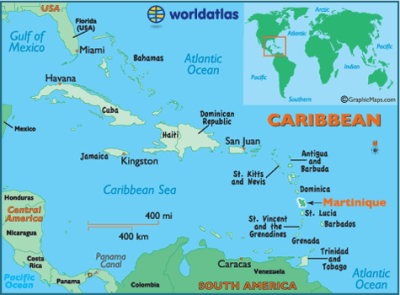www.hovedsteder.blogg.no is a Norway-based blog about the capitals of the world, with a focus on tourism, travel, transport, the environment, politics, diplomatic affairs, lifestyle, culture and entertainment, food and drink.
Se også vår reiseblogg / see also our travel blog at www.minbestereise.blogg.no – contact us a hovedsteder@gmail.com
Martinique has announced a “not-to-be-missed” walking tour of Fort-de- France, the www.cruiseindustrynews.com website reported.
Among the highlights are:
Fort Saint Louis – Originally carved from a rocky promontory jutting out into The Bay of Fort-de-France, Fort Saint Louis dates back to 1640. Recently closed, when it was reinstated as an active military installation, the fort reopened to the public July 2014.
La Savane Park – The 12-acre Park built in the 18th century from land reclaimed from the sea and mangroves was originally used for training by French military stationed at Fort Saint Louis. In 1830 La Savane became known as Le Jardin du Roi (The Garden of the King). Its new purpose: to harbor scientific experiments on plant species that were new to the island, many of which are still present in the Park today.
Schoelcher Library – erected for the same 1889 World Fair in Paris that saw the debut of the Eiffel Tower, the Schoelcher Library stands as a tribute to French abolitionist Victor Schoelcher. Designed by Henri Picq, a contemporary of Gustave Eiffel, the library was dismantled piece by piece following the World Fair, shipped to Martinique, and reassembled in Fort-de-France along Rue de la Liberté just across from the La Savane Park.
Saint Louis Cathedral – also designed by Henri Picq, the Saint Louis Cathedral has a Gothic Revival architectural style standing out as the most prominent structure in downtown Fort-de-France. The Cathedral in its current form was built in 1895, though it is the seventh such church built on the same location one block northwest of La Savane since 1657.
All previous churches were destroyed by fire or natural disasters, prompting Picq to construct its entire frame out of steel, earning the structure the nickname “The Iron Cathedral”.
Le Marché Couvert – another Picq design, the Covered Market was originally constructed in 1901 and later restored in 1989. Bustling, it’s still the place to go for local Martinican spices, herbs, fruits, vegetables, arts and crafts. The restaurants within the market offer local cuisine.
Aimé Césaire Theater – Formerly the City Hall of Fort-de-France, where playwright, statesman, and civil rights leader Aimé Césaire maintained an office for more than 50 years, the Théâtre Aimé Césaire presents an example of Neoclassical architecture in the Caribbean. Constructed between 1884 and 1901, the building now houses a museum dedicated to Césaire upstairs.
To help visitors enjoy all that Fort-de-France has to offer, the city’s Tourism Office recently launched new self-guided audio tour maps. Available for rent through The Fort-de-France Tourism Office, the new maps are equipped with audio pens that enable visitors to hear details on featured attractions simply by pointing the pens on the attractions on the map.
Audio is available in a choice of English, French, Spanish, and Italian, with additional languages to be added in the coming months.
#By #Ferie #FortDeFrance #Frankrike #Hovedstad #Karibia #Martinique #Reise
#Capital #Caribbean #City #France #Holiday #Travel





Ha en fin dag;)
kine: Takk for det, samme til deg